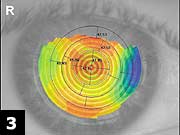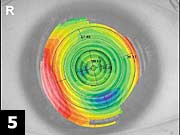Adding a hyperopic component to myopic corrections yields larger optical zones
Patients achieved better contrast sensitivity, better visual acuity at night and an overall improved quality of vision.
ROME – Adding a hyperopic component during correction of myopia or myopic astigmatism produces larger optical zones and better quality of vision, according to two surgeons here.
This method yielded larger optical zones than customized treatment, said Angelo Appiotti, MD, and Marco Alberti, MD, who are now employing the technique as a standard procedure.
The idea first came from patients who were re-treated for overcorrection after refractive surgery.
“After we had taken off the 2 D or 3 D of overcorrection, we found that topographic results were remarkably better, with much larger optical zones than after a standard myopic treatment. We thought perhaps the use of a hyperopic component in addition to a myopic treatment, with reduced transition zones for tissue sparing, might result in a much wider final optical zone.
“In fact, what would have been a final 5.5-mm optical zone with standard treatment came out as an actual 7-mm zone after re-treatment. Patients were happy. Not only had they achieved emmetropia, they also had a better quality of vision than ever before,” Dr. Appiotti said.
Enlarging small optical zones
The surgeons began using the technique to enlarge the optical zone in patients who had undergone refractive surgery. They chose patients who were close to 20/20 but had small optical zones and problems with glare and halos.
“We calculated how to enlarge these small optical zones, making smooth transitions between the center and the periphery. We could perform, for example, a –2 sphere and +2 sphere with an optical zone of 6 mm and a transition zone of 7 mm to 8 mm for the myopic component, and a fixed 5.5-mm optical zone and 9-mm transition zone for hyperopia,” Dr. Appiotti said
Few topographic variations were seen, but patients reported a marked improvement in visual quality, he said.
First treatment
The technique was then applied as a first treatment in myopic patients with large pupils. The first case was treated with a standard customized procedure in one eye, using the largest possible optical zone, and with combined myopic-hyperopic treatment in the other eye.
“We had to correct a –4 D myopic defect in both eyes. In the right eye, we set a –4 D, with an optical zone of 6.5 mm and transition zone of 8.5 mm. In the left eye, we performed our new procedure, setting a +2 sphere treatment with 5.5-mm optical zone and 9-mm transition zone plus a –6 sphere treatment with 6.5-mm optical zone and 7.5-mm transition zone.
“We could keep the transition smaller than average and spare some tissue, as the myopic treatment works in the center, and the hyperopic treatment in the periphery,” Dr. Appiotti explained.
In the first eye, a final optical zone of 5.75 mm was obtained. In the other eye the optical zone was 7 mm.
“It is a significant difference. In both eyes the patient is 20/20, and very happy, but we can see topographically a very clear red knee surrounding the optical zone in the right eye. In the left one, we have a smoother and larger topographic image, with no red knee surrounding the optical zone,” Dr. Appiotti said.
“In this eye we used a deeper and smaller central myopic ablation with short transition, but the 9-mm peripheral hyperopic ring has blended with the myopic transition, resulting in a smooth 7-mm optical zone. This outcome in a mydriatic patient means much better contrast sensitivity, better visual acuity at night and an overall improved quality of vision,” he said.
Astigmatic treatment
These results encouraged the surgeons to continue applying the technique, using the hyperopic component also in the treatment of myopic mixed astigmatism, which they used to treat successfully with the cross-cylinder technique.
“We treated, for example, a –6 sphere –2 cylinder at 180° using a –8 sphere with single 6-mm optical zone without transition, and a +2 cylinder at 90° with a 5.5-mm optical zone and 9-mm transition zone,” Dr. Alberti said.
Postoperative topography shows minimal keratometric variations in the 6-mm zone, with no sudden change in the gradient of curvature and an elliptic optical zone at 180°.
“One problem of this kind of treatment could be that a larger quantity of tissue is ablated because the myopic spherical component is increased. However, if we reduce or eliminate the myopic transition zone, and on the other hand increase the hyperopic transition zone from 8 to 10 mm, the final ablation does not differ greatly from other types of treatment,” Dr. Alberti said.
A similar pattern of treatment is used when cylinders are against-the-rule. A case of –4 sphere, –3 cylinder at 115° was treated using a —7 sphere, +2 cylinder at 25°. Hyperopic treatment was performed using a 5.5-mm optical zone and a 9-mm transition zone, while the myopic treatment was done on a 6-mm optical zone with a 7-mm transition zone.
“As in the previous case, postoperative topography showed very good results in the cylinder, and a final elliptic optical zone more than 6-mm wide at 100°,” Dr. Alberti said.
“The rewarding results we have obtained encourage us to believe that our technique may open new horizons in the correction of all kinds of refractive defects,” he added.
|
|
|
|
|
|
For Your Information:
- Angelo Appiotti, MD, can be reached at Via Mantova 44, 00198 Rome, Italy; phone/fax: (39) 06-841-7307; e-mail: klan@appiotti.it.
- Marco Alberti, MD, can be reached at Centro Medico Italiano, Via San Pietro all’Orto 3, 20122 Milano, Italy: (39) 02-7600-9801; fax: (39) 02-7600-9413; e-mail: marco.alberti@fastwebnet.it.





